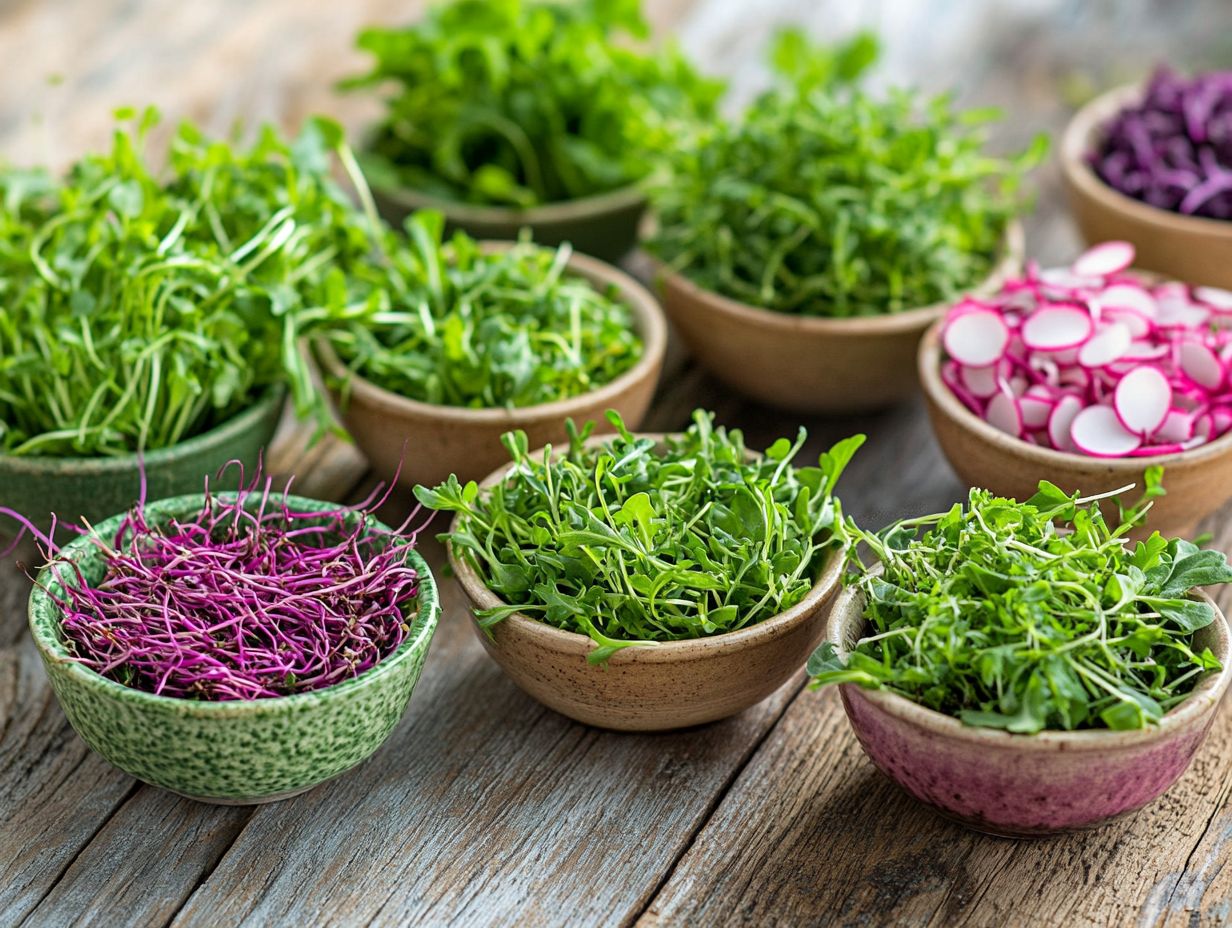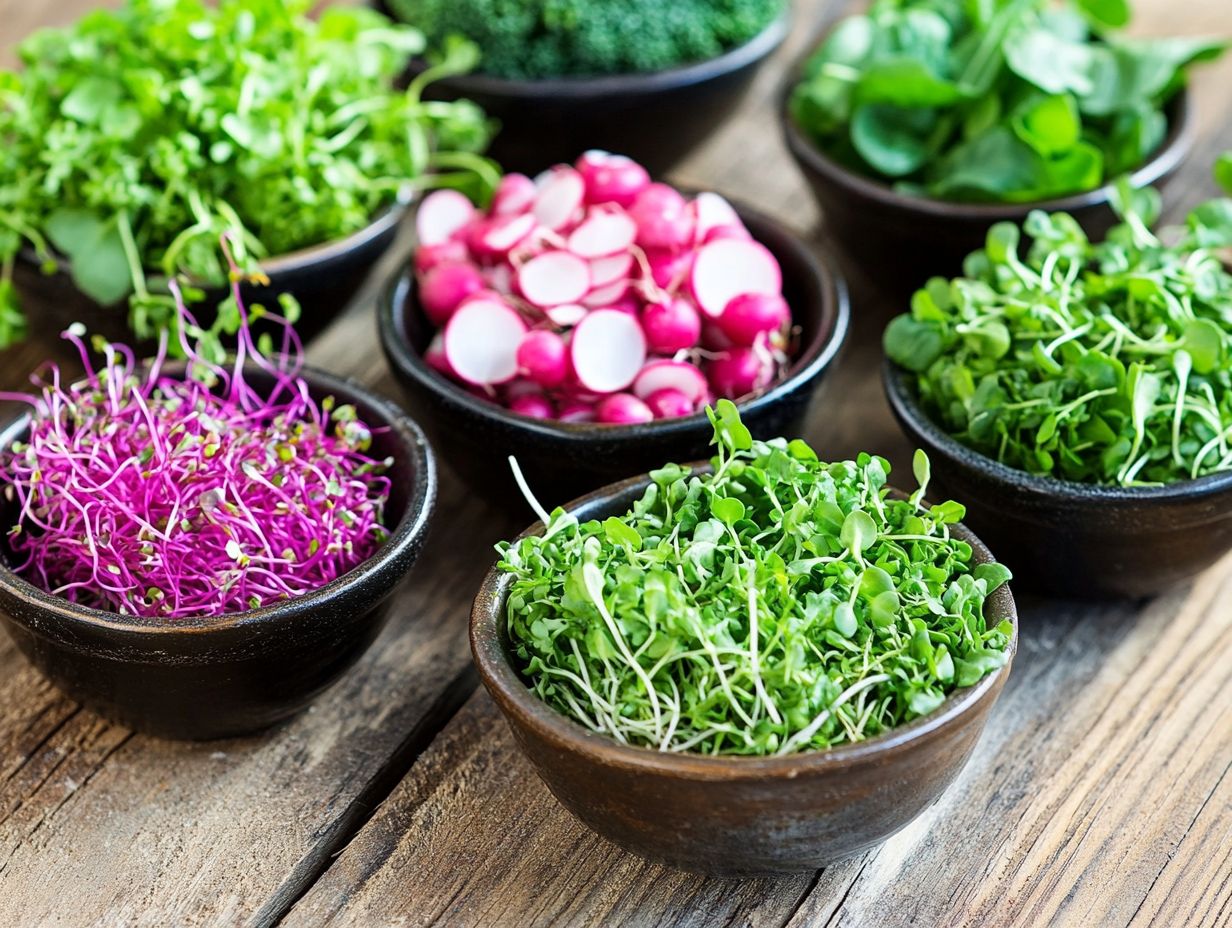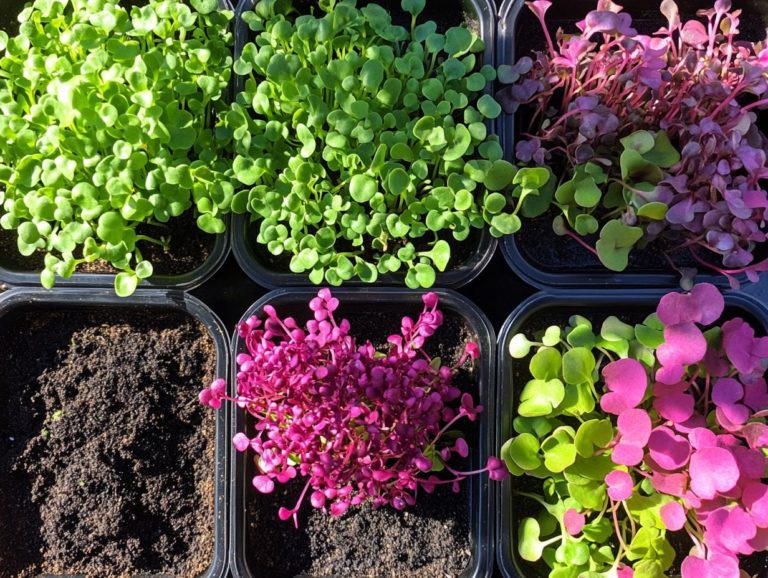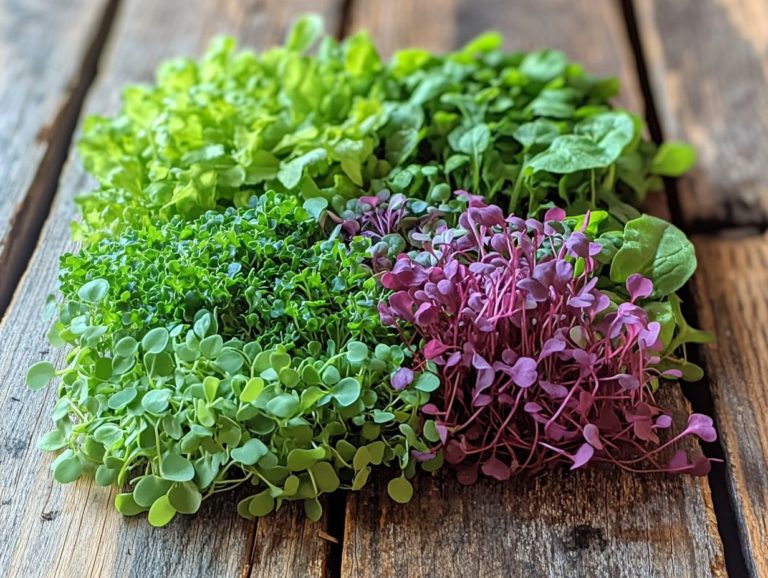5 Microgreens that Help with Inflammation
Microgreens are more than just a trendy garnish on your plate; they deliver a remarkable nutritional boost that can greatly enhance your health, showcasing varieties of microgreens that enhance your cooking.
Delve into the captivating world of microgreens and their interesting connection to inflammation, particularly through the antioxidant properties and polyphenols a type of antioxidant found in many plants these tiny greens provide. Discover how specific varieties, such as broccoli microgreens, kale, and radish microgreens, can help mitigate inflammatory responses in your body.
You can also find practical tips for seamlessly adding these tiny greens to your diet, alongside other effective strategies for managing inflammation.
Whether you re an experienced culinary enthusiast or simply curious, discover why adding microgreens to your meals is a game-changer for your health!
Contents
- Key Takeaways:
- 1. What Are Microgreens?
- 2. The Link Between Inflammation and Diet
- 3. Broccoli Microgreens
- 4. Kale Microgreens
- 5. Radish Microgreens
- 6. Cilantro Microgreens
- 7. Wheatgrass Microgreens
- 8. How to Incorporate Microgreens into Your Diet
- 9. Other Ways to Reduce Inflammation
- 10. Are There Any Risks or Side Effects?
- Why Are Microgreens a Good Addition to a Healthy Diet?
- Frequently Asked Questions
Key Takeaways:

- Boost your meals with microgreens and fight inflammation naturally due to their high levels of antioxidants and anti-inflammatory compounds.
- Broccoli, kale, radish, cilantro, and wheatgrass microgreens are specifically beneficial for reducing inflammation.
- Incorporating microgreens into your diet can be as easy as adding them to salads, sandwiches, or smoothies, like incorporating pea shoots for added texture and flavor.
1. What Are Microgreens?
Microgreens are those delightful young plants you ll want to harvest just after their first true leaves have sprouted. They add a burst of color and flavor to your meals while being packed with nutrients, antioxidants, and versatility that can elevate a variety of cuisines. Think of arugula, basil, and broccoli these tiny greens not only enhance your culinary creations but also deliver impressive health benefits, like supporting gut health and boosting your immune system. If you’re passionate about home gardening, growing microgreens is a fantastic way to enrich your diet with fresh vegetables and herbs.
With a wide range of microgreens at your disposal like the peppery mustard greens or the mild, nutty sunflower shoots the possibilities for culinary creativity are endless. These tiny greens are not just tasty; they pack a nutritional punch! They re powerhouses loaded with essential vitamins such as Vitamin C and minerals like iron, making them a superb choice for salads, sandwiches, and even smoothies.
Embarking on the journey of growing microgreens is surprisingly approachable. You can use methods like hydroponics or traditional soil planting, and they require minimal space, making them ideal for urban gardeners. Plus, with a quick harvest time of just 7 to 21 days, you can enjoy the satisfaction of home-grown produce without the long wait.
2. The Link Between Inflammation and Diet
The connection between inflammation and diet is becoming increasingly clear, with a growing body of research highlighting how certain foods can either worsen or improve inflammatory conditions, significantly impacting your overall health.
A diet rich in antioxidants and polyphenols can be crucial for reducing these inflammatory processes. Antioxidants work to combat damage caused by free radicals, which is often tied to chronic inflammation, while polyphenols plentiful in foods like berries, nuts, and especially microgreens offer unique health benefits.
For example, when you incorporate spinach and kale into your meals, you’re not just adding a wealth of vitamins; you’re also boosting your intake of anti-inflammatory compounds. Similarly, omega-3 fatty acids in fatty fish like salmon can help lower inflammation levels.
By choosing these nutrient-dense foods, you can actively support your body s defenses against inflammation, paving the way for better health.
3. Broccoli Microgreens
Broccoli microgreens are celebrated for their remarkable nutrient profile. They boast high levels of vitamin C and antioxidants, making them a powerful ally in promoting overall health and combating oxidative stress.
Rich in sulforaphane, a compound known for its anti-inflammatory properties, they can help reduce chronic inflammation and enhance your body’s defense mechanisms. These tiny greens, especially the top 5 microgreen varieties for breakfast, also support gut health by fostering good bacteria in your gut.
Adding broccoli microgreens to your meals is easy. You can toss them into salads, smoothies, and sandwiches, or use them as a garnish for soups and main dishes. If you’re interested in growing your own, they can be cultivated indoors or outdoors with minimal effort, using either soil or hydroponic systems. Don’t miss out on the chance to enjoy the benefits of this nutritious powerhouse.
4. Kale Microgreens
Kale microgreens are a delightful variant of brassica vegetables. These nutrient-packed powerhouses elevate your vitamin A and K levels, which are essential for maintaining both bone and skin health.
These little greens are bursting with antioxidants, offering a protective boost against oxidative stress a key contributor to chronic diseases. With a high concentration of vitamins C and E, they enhance your immune system and skin vitality.
Incorporating these vibrant greens into your meals is simple. Toss them into salads for that perfect crunch or blend them into smoothies for an extra nutrient kick.
For optimal growth, kale microgreens thrive in a well-drained soil mix and need plenty of light aim for around six hours a day. Growing them at home is rewarding and brings their remarkable health benefits within reach.
5. Radish Microgreens
Radish microgreens are not just a feast for the eyes; they bring a delightful peppery flavor and a wealth of health benefits. They are packed with potent antioxidants that help shield your cells from damage.
These tiny greens are a nutritional powerhouse, filled with essential vitamins like A, C, and K, along with minerals like calcium and magnesium that promote overall health and well-being. Their vibrant colors and crisp texture make them an excellent addition to salads, sandwiches, and wraps.
They can elevate a simple stir-fry or grain bowl, adding a fresh, zesty note that harmonizes beautifully with various ingredients. Incorporating 5 microgreens to add to your smoothies into your meals supports digestion and enhances heart health, making them a wise choice for enriching your diet.
6. Cilantro Microgreens

Cilantro microgreens are a fragrant and flavorful choice that can elevate your dishes with a burst of freshness. They offer notable health benefits like aiding digestion and having anti-inflammatory properties.
These tiny greens are perfect for enhancing salsas, salads, and soups. They improve the visual appeal of your meals and enrich the overall taste profile. Chefs frequently use cilantro microgreens to elevate tacos and grain bowls, infusing them with a zesty note that complements a wide array of flavors.
Beyond their culinary versatility, cilantro microgreens provide significant nutritional advantages. Packed with vitamins and antioxidants, they support better digestive health. Incorporating them into your diet helps break down food more efficiently, making your meals more enjoyable and healthier.
7. Wheatgrass Microgreens
Wheatgrass microgreens are known for their vibrant green color and impressive nutrients. They offer a wealth of antioxidants and essential vitamins that boost your overall well-being.
These tiny powerhouses are packed with chlorophyll. This helps detoxify your body and enhances your complexion while boosting your immunity.
To easily add these greens to your daily routine, toss a handful into smoothies or fresh juices. Their earthy flavor pairs beautifully with fruits and other vegetables.
Enjoy their benefits in a morning shake or a refreshing drink!
8. How to Incorporate Microgreens into Your Diet
Adding microgreens to your meals is simple and fun. They elevate your dishes and improve your health, whether you re cooking with arugula or making fresh salads with radish microgreens.
These tiny greens burst with flavor. For example, spicy radish microgreens add a zesty kick to egg salad, transforming it into a standout sandwich filling.
You can also toss basil microgreens into a fresh caprese salad for extra taste and visual appeal.
If you re blending a smoothie, sprinkle in some pea shoots for a touch of sweetness. They also significantly boost the nutritional value.
When garnishing soups, vibrant broccoli microgreens add a crunchy texture and fresh flavor to creamy bases.
Experiment with these versatile greens and turn cooking into an exciting flavor journey!
9. Other Ways to Reduce Inflammation
Besides microgreens, many strategies help reduce inflammation. Making smart food choices and lifestyle changes can greatly enhance your health.
Regular physical activity is key. Exercise helps you maintain a healthy weight and releases anti-inflammatory compounds in your body.
Staying hydrated is also vital. Water flushes out toxins and supports optimal cellular function.
Incorporating superfoods like berries, leafy greens, nuts, and fatty fish into your meals elevates your antioxidant levels, which combats stress in the body.
Small lifestyle changes, such as prioritizing restorative sleep and managing stress through meditation, can create a more balanced inflammatory response.
10. Are There Any Risks or Side Effects?
While microgreens are generally safe and healthy, be aware of potential risks like contamination and handling practices.
Source your microgreens from reputable suppliers who maintain high hygiene standards. This reduces the risk of foodborne illnesses.
Always wash microgreens thoroughly before enjoying them. This ensures any dirt or pathogens are removed.
For safe consumption, store microgreens in clean containers and keep them refrigerated to maintain freshness.
Be mindful of allergies, especially with microgreens from the mustard family, which can provoke reactions in sensitive individuals. Consult a healthcare professional if unsure about specific varieties.
Why Are Microgreens a Good Addition to a Healthy Diet?
Microgreens are a fantastic addition to your healthy diet. They are packed with nutrients and essential vitamins.
These tiny greens are rich in nutrients like vitamins A, C, E, and K. They also contain antioxidants that boost your immune function and protect your body from stress.
To seamlessly incorporate these nutrient-packed powerhouses into your daily meals, consider:
- Tossing them into salads for added freshness
- Layering them in sandwiches for a delightful crunch
- Blending them into smoothies for that extra nutritional punch
Simple recipes like microgreen pesto or a refreshing microgreen salad can elevate the nutrient profile of your everyday dishes.
What Are the Other Health Benefits of Microgreens?

In addition to their culinary versatility, microgreens provide a wealth of health benefits. They boast high levels of antioxidants and a significant dose of vitamin C.
These tiny greens think broccoli, kale, and radish sprouts are not just nutrient powerhouses; they’re also formidable allies in promoting gut health. Their impressive fiber content supports digestion and helps maintain a balanced microbiome, essential for optimal immune function and effective nutrient absorption. Incorporating 5 microgreens that support healthy aging can further enhance your diet.
Certain varieties, like cilantro and basil, contain potent anti-inflammatory compounds that may reduce the risk of chronic diseases. By incorporating these nutrient-dense microgreens into your meals, such as 5 nutritious microgreen varieties for smoothies, you can elevate your meals and boost your immunity—it’s never been easier or tastier!
How Do Microgreens Compare to Other Anti-Inflammatory Foods?
Microgreens pack a remarkable nutrient density compared to other anti-inflammatory foods. They are a powerful ally in your anti-inflammatory diet.
Unlike familiar options like berries and fatty fish, microgreens deliver an astonishing concentration of vitamins, minerals, and antioxidants in just a small serving. Certain varieties, such as 5 microgreens to boost your metabolism, can contain up to 40 times more nutrients than their mature counterparts, providing concentrated benefits for your health.
They bring a delightful array of flavors and textures to your dishes, enhancing your culinary creations while aiding in inflammation reduction. Their versatile nature makes it easy to incorporate them into salads, smoothies, or sandwiches, allowing you to reap significant health advantages, including those found in 5 microgreens to boost energy levels, without extensive preparation.
Can Microgreens Help with Specific Types of Inflammation?
Microgreens have incredible potential in addressing specific types of inflammation, thanks to their rich nutrient content and impressive antioxidant properties. This can be particularly beneficial for alleviating symptoms associated with conditions like arthritis and gut inflammation.
By incorporating varieties such as broccoli, radish, and beet microgreens into your diet, you can tap into beneficial compounds that work together to reduce inflammation. These tiny greens are brimming with vitamins A, C, and E, which combat oxidative stress, a key contributor to chronic inflammation. Notably, plant-based antioxidants like sulforaphane found in broccoli microgreens inhibit inflammatory pathways. For a delicious twist, consider adding the top 5 microgreens for smoothies to your recipes.
This makes microgreens a powerful ally for anyone looking to manage not just pain, but the overall burden of inflammatory diseases.
Are There Any Studies Supporting the Benefits of Microgreens for Inflammation?
Numerous studies have explored the benefits of microgreens for inflammation. These studies show their potential to reduce inflammatory markers and enhance health.
Research indicates that these young greens are packed with essential nutrients like vitamins C and E, along with antioxidants, which are effective in battling inflammation. For instance, one study highlighted how glucosinolates compounds in some microgreens can help fight inflammation and bolster your body’s defense against oxidative stress. Exploring microgreen varieties that boost your immune system can further enhance your health.
Polyphenols in microgreens like beet and radish help reduce pro-inflammatory cytokines. Incorporating these nutrient-dense greens into your diet offers a simple yet powerful strategy to support your immune system and promote overall wellness.
What Are Some Delicious Recipes Using Microgreens?
Dive into delicious recipes featuring microgreens and elevate your meals today! For example, try sourcing from Revity Farms for fresh microgreens.
These tiny greens brim with flavor and nutrients, transforming ordinary salads, sandwiches, and even stir-fries into vibrant culinary experiences. Imagine adding peppery arugula microgreens to a classic pesto for a unique kick, or incorporating delicate pea shoots for a sweet crunch in a simple omelet. Additionally, consider exploring 5 microgreens that are good for your heart to enhance your dishes further.
When you blend kale or cabbage microgreens into your smoothies, you enhance their nutritional profile and introduce a subtle earthiness that pairs beautifully with fruits. By experimenting with different varieties, you ll discover how these little gems enrich your palate while contributing to your overall health.
Frequently Asked Questions
What are microgreens?

Microgreens are young vegetable greens harvested after the sprout stage, but before they reach full maturity. Typically 1-3 inches tall, they are packed with nutrients.
How can microgreens help with inflammation?
Microgreens contain high levels of antioxidants that can reduce inflammation in the body. Consuming them regularly helps prevent and alleviate symptoms of chronic inflammation.
Which microgreens are known to have anti-inflammatory properties?
The top 5 microgreens known for their anti-inflammatory properties are broccoli, kale, arugula, parsley, and basil. These microgreens are rich in antioxidants and other nutrients that help reduce inflammation in the body.
How can I incorporate these 5 microgreens into my diet?
Microgreens can be easily added to your diet by including them in salads, smoothies, sandwiches, or as a topping on soups and dishes. They also make great garnishes, adding a pop of flavor and nutrients to any meal.
Are there any other benefits to consuming microgreens?
Yes, microgreens offer more than just anti-inflammatory benefits. They are high in vitamins, minerals, and other nutrients that support overall health and well-being. Low in calories, they can be a great addition to a healthy diet.
Can anyone consume microgreens?
Absolutely! Microgreens can be enjoyed by anyone, including children and older adults. However, it is always best to consult with a healthcare professional before making significant changes to your diet, especially if you have existing health conditions.






